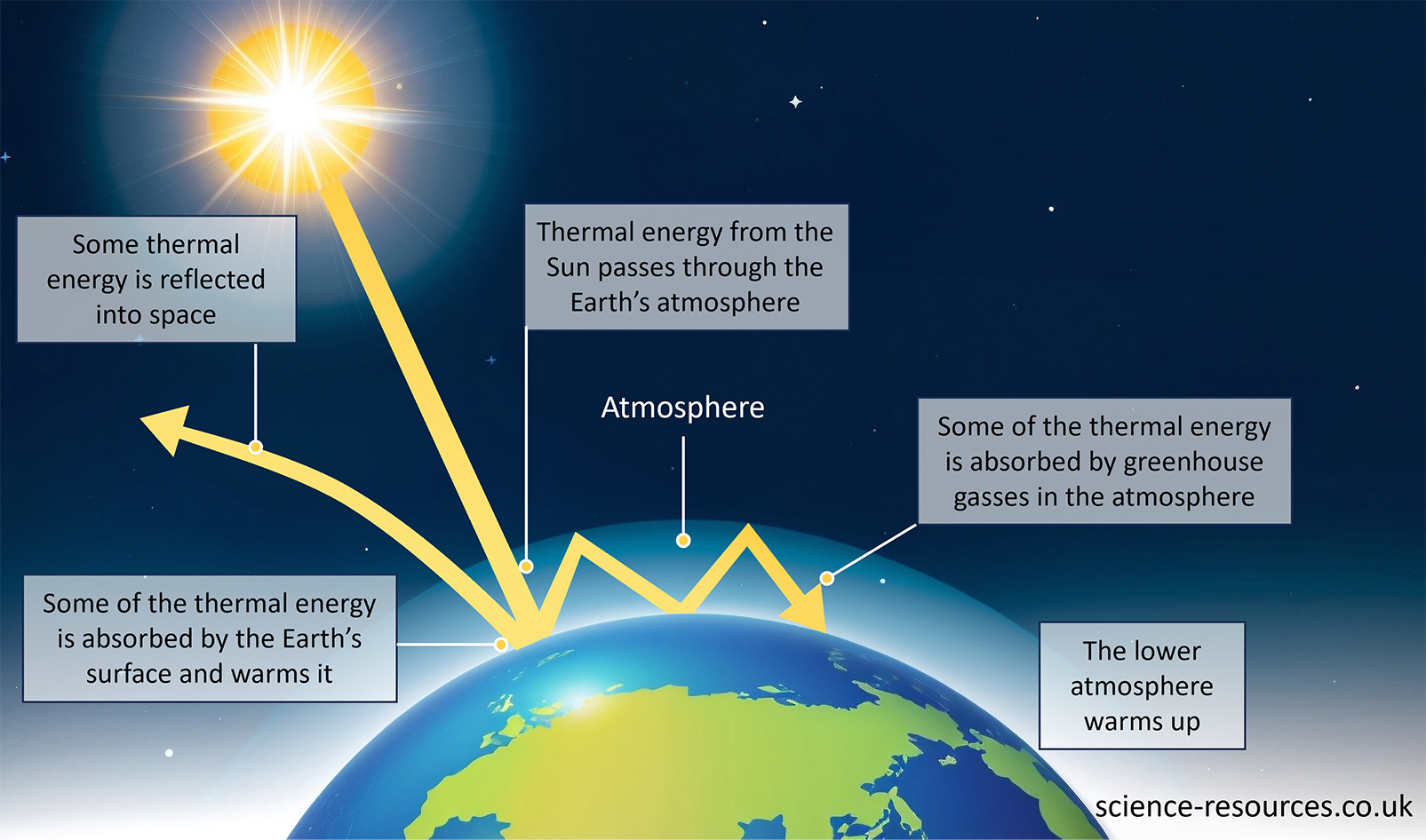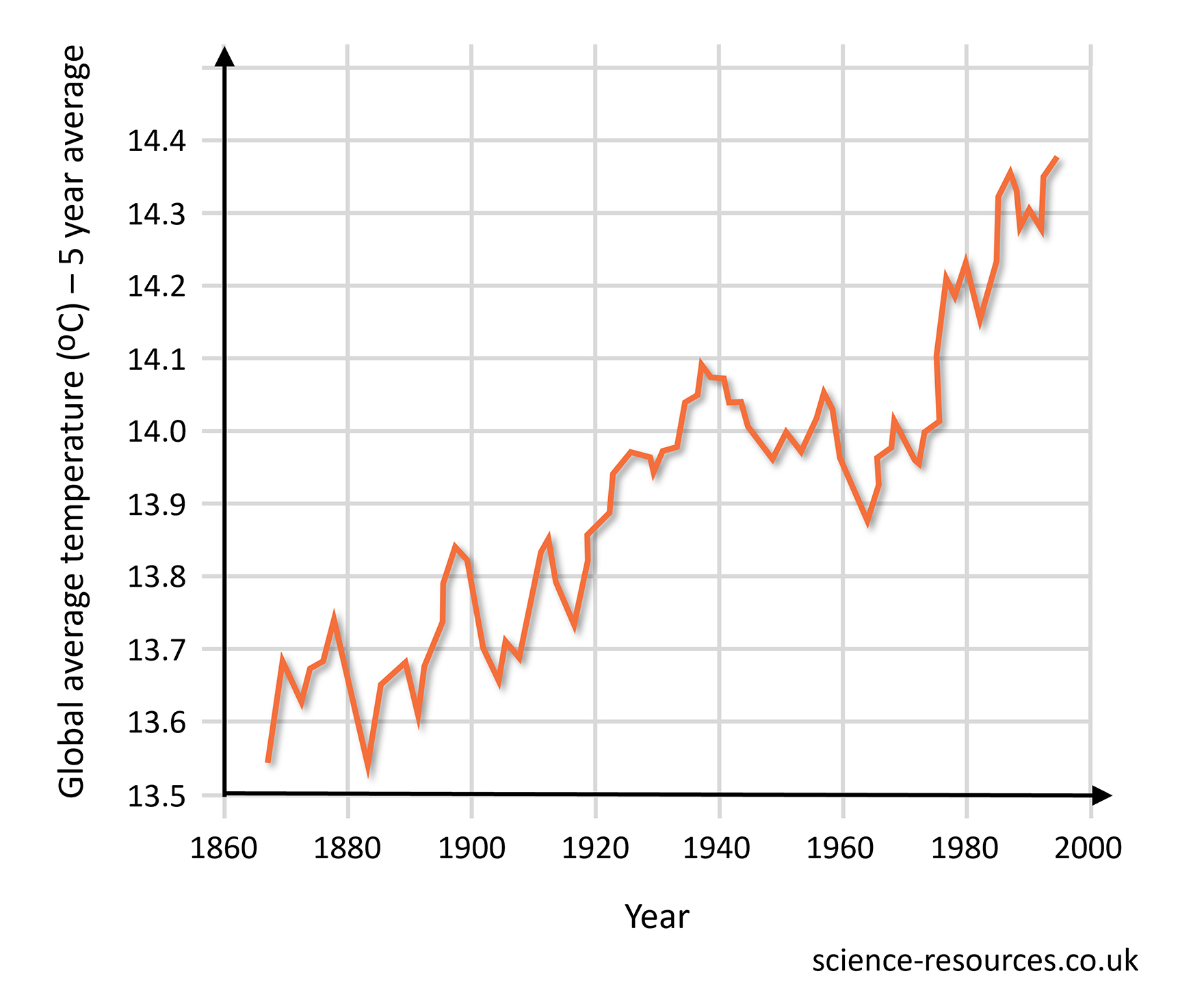Greenhouse gases and climate change
The greenhouse effect The greenhouse effect. Carbon footprint Climate change Graph showing how the average temperature of the Earth has increased in recent years.
The Sun sends out thermal energy (or heat energy) that reaches the Earth. This thermal energy is essential for life on Earth. But not all of the thermal energy that reaches the Earth stays here. Some of it bounces off pale, shiny surfaces like ice and goes back into space.
Some gases in the atmosphere, called greenhouse gases, trap some of the thermal energy that is trying to escape. This makes some of the thermal energy go back to the Earth and warm it up. This is called the greenhouse effect. It is like being in a greenhouse or a car with the windows closed on a sunny day, which is much warmer than a cloudy day. As the amount of greenhouse gases in the atmosphere increases, the Earth gets hotter.
The carbon footprint is the amount of carbon that our activities release into the atmosphere. Some activities do not add any extra carbon dioxide to the atmosphere and are called carbon neutral. These have no impact on our carbon footprint. For example, going to school by walking or cycling is carbon neutral.
Some activities take carbon out of the atmosphere and store it. This also lowers your carbon footprint. Growing trees or other plants is an important way to remove carbon from the atmosphere.
The greenhouse effect is stronger when there is more carbon dioxide in the atmosphere. This traps more heat energy from the Sun, making the planet warmer than it should be. This rise in the Earth’s temperature is called global warming.
Climate scientists agree that the higher levels of carbon dioxide and other greenhouse gases are directly related to the higher global temperatures. Global warming is affecting the world’s climates. This is called climate change.
The impact of climate change What can we do to reduce greenhouse gas emissions? 1. Using cleaner energy 2. Recycling waste 3. Growing more plants 4. Reducing food miles While most of the emissions come from big companies, there are still some ways that we can change our daily lives to lower our own personal carbon footprint. You can buy locally or even grow your own fruits and vegetables. Even something as simple as turning off the water while you brush your teeth or switching off electric devices completely is enough to lower the energy you use at home.
Greenhouse gases have a huge impact on climate change. They change the Earth’s climate, which can harm life on Earth. These are some of the ways that greenhouse gas emissions affect our planet:
We need to act now to lower greenhouse gas emissions — before it’s too late. Many governments around the world are starting to take steps towards a greener future. Here are some of the ways that they are trying to reduce greenhouse gases:
One of the biggest sources of greenhouse gas emissions is the use of fossil fuels. Coal and oil are a steady source of energy for now, but they will run out someday and they cause a lot of pollution. Instead of depending on these harmful fossil fuels, we’re switching to cleaner energy such as solar power, hydroelectric, and wind power. These energy sources are clean, which means they don’t produce any or very little greenhouse gases.
Waste and garbage also contribute a lot to pollution. When materials decay and break down, they make methane, and many materials don’t break down properly at all. In fact, they can stay in the garbage for hundreds or even thousands of years. To prevent this, it’s important to recycle materials so that they can be used again instead of going to waste. Some of the most important materials to recycle are plastic, paper, metal and glass.
Plants help to fight global warming because they take in carbon dioxide. But human activities have destroyed many forests and grasslands, which means there are fewer plants. So, one of the things we can do to fight global warming is to restore plant life. Planting trees, moss and other plants are some ways to do this.
Food can travel a long way to get to your store! Planes, cars and trucks all make pollution when they run, and when food is moved this way, it adds up ‘food miles’. You can lower the amount you add to this by buying food locally — this could mean buying food from a nearby farm or just something that’s been grown in your own country.
Summary: